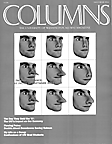
December 1994 Columns
Letters to the editor are encouraged. Brief letters are more likely to be published; longer letters may be edited due to lack of space. Please address all correspondence to: Editor, Columns Magazine, 1415 N.E. 45th Street, Seattle, WA 98105. You may send e-mail to columns@u.washington.edu on the Internet .

December 1994 Columns
Your recent article on the lowering of reservoirs on the Columbia and Snake Rivers in order to save salmon was interesting ["Flowing Pains," December 1994]. I believe the author needed to finish telling the story.
... We do know that up to 95 percent of the smolts leaving the Columbia die, so, in the overall picture and in the decision of the drawdowns, it is irrelevant to me what the survival at the Lower Granite Dam is. Action is needed now. Where there are only one or three or six sockeye salmon returning to Idaho's Redfish lake, any percent mortality at any dam is too much. We also know that smolt migration from Idaho to the sea, when the watershed was a river, was about two weeks, and now, through a series of reservoirs, it is about two months. It seems quite obvious that the system needs to be a river again during the spring/summer outmigration periods.
Are the Columbia salmon runs worth sacrificing to provide cheap power to Southern California and industries? You would have a hard time convincing a commercial or sports fisherman. To me this is the problem with the "Lesser 48": Greed! In this political, industrial and scientific stalemate, the only losers are the salmon and future generations. As Gov. Cecil D. Andrus has said, "We are going to study the salmon to death and then the point (drawdowns) will be mute."
Keith Carpenter
Juneau, Alaska
Your article in Columns entitled "My Life as a Dawg" brought back fond memories of my own "kennel" life at the "U Dub." I matriculated as a grad student in the zoology department back in 1963. After five years of graduate student life, I left with my Ph.D. having experienced much of what author Jon Marmor chronicled in his article.
However, 30 years ago, life was simpler: my monthly stipend as a TA/RA ran approximately $233 a month, out of which I supported myself with rent and car payments with a few dollars remaining for food and entertainment. Also at that time tuition costs were much lower, to the point of being non-existent. I recall receiving a statement of approximately $150 a quarter to cover tuition and incidental fees.
There were great times and experiences as well: Summer Quarters in residence at the Friday Harbor Laboratories in the San Juan Islands, wonderful mentor professors that nurtured my development in the zoology department: Paul Illg, Alan Kohn, Dick Fernald; and finally the opportunity to continue in the capacity as a scholar/scientist for the remainder of my life.
Dan Hoffman, '68
Professor of Biology
Bucknell University
Lewisburg, Pa.
Regarding the cover article in the last issue of Columns ["Making the Puppet Dance," December 1994], I am a 1987 UW graduate with a B.F.A. in Industrial Design. I now work as a software designer for Boeing Computer Services. I work in a team made up of systems analysts, programmers, cognitive psychologists and other business professionals.
Creating quality software that is usable by humans is a team effort requiring many skills and expertise. Industry has come to recognize this. Companies like Boeing are taking great effort to foster interdisciplinary collaboration across organizations.
Cross-pollination of knowledge and ideas is a critical ingredient to education. The gene pool inside each department will always be limited. Work such as Judith Ramey's classes in Usability Testing is a great asset in bringing about more interdisciplinary activities, as is the UW Human Interface Technology Lab. As a UW graduate with concern for the future of the University, I would be pleased to hear more of such cooperation between the isolated empires on campus. Students would grow in their understanding and appreciation for the other areas of expertise which they will need to team together with in the workplace.
In this model, programs such as Industrial Design, which is by nature a hybrid of design and engineering, would not be held hostage within their departments but could interact more freely with other disciplines. Such interaction is necessary for survival in the business community. It should not come as a surprise that isolation may lead to the demise of a program in education.
Roger E. Belveal, '87
Seattle
Editor's Note: The recent President's Task Force Report recommended strengthening interdisciplinary learning at the University.
During my UW graduate years, 1954-58, I once had to visit a certain third-floor department which had a work and storage area in the fourth-floor attic above. There we spread out tables, maps, trays and so forth in a place pleasant and well-lit, but not suitable for classrooms or faculty offices.
Slowly it became apparent to us that there must be a corresponding--and hopefully unused--similar space in Gowen Hall, the abutting building. We assumed that the only attic entry was from the top floor of the law school located below.
Quiet investigation revealed the area was unused. Certain that a formal request for the space would produce an automatic refusal, we opened up (perhaps in weekend hours) a connecting passage and simply expanded into the new space.
Of course, it gradually dawned on the law school that they had been invaded overhead, but by then it was too late. The victims could no longer claim their great need for the space, especially when they remained unaware of the take-over. One would expect lawyers to know that "possession is nine-tenths of the law!"
I think of the episode now and then, and it provides another colorful memory of distant days, now four decades old.
John R. Krueger, '60
Bloomington, Ind.
Send a letter to the editor at columns@u.washington.edu.